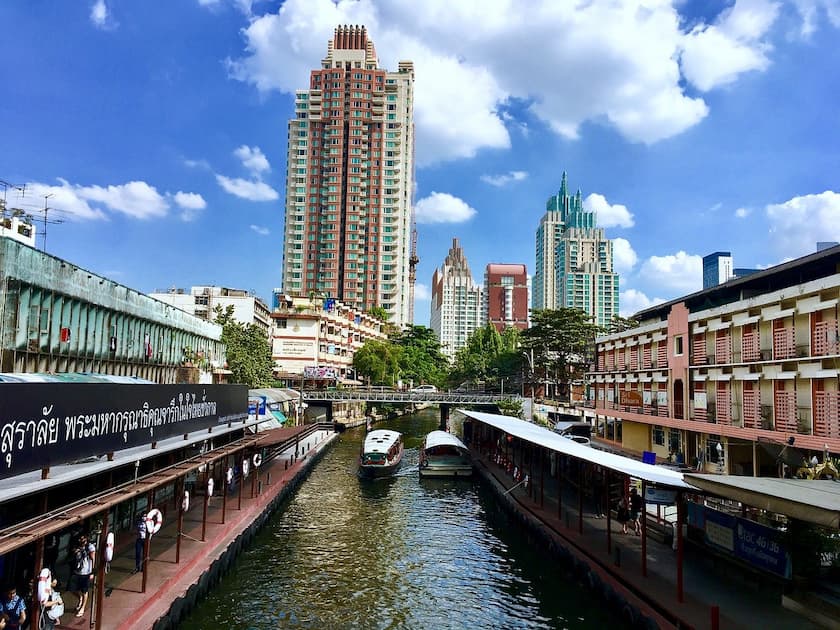Explore Bangkok's Canals
Bangkok is an extraordinary place of intricate architecture and beautiful scenery. This charming city boasts an array of historical buildings and traditional waterways. These beautifully sculpted rivers and canals were developed in the 18th century when Bangkok took on a new role as the capital of Thailand. No trip to Bangkok would be complete without an exciting tour of Bangkok’s many man-made canals. In fact, many first-time visitors simply travel the city by boat. This introduces them to the marvellous attractions of the Chao Phraya River. While many of these canals have been paved to incorporate roads, Bangkok’s waterways, or “Khlongs”, will forever serve as relics for culture, and hold historical significance to Bangkok’s eccentric structure.

History of Bangkok’s Waterways
Bangkok’s waterways date back to ancient times. They were originally created as a method of defence after an attack by the Burmese left the city burned to the ground. Officials wanted to ensure the new capital had a stable line of defence and protection against foreign threats. Therefore, the waterways and canals were designed specifically to protect the city. Forts were also stationed at certain points along the river. When the threat of invasion decreased, the waterways remained and were used to aid the city in international trading. By incorporating these winding canals, the city was able to build profitable relationships with the merchants who visited. Most of these merchants were from China. However, merchants from Spain and the Netherlands found value in Thailand as well. Foreign merchants needed a quicker, more efficient way to travel within the city, so these intricate canals were created in the 16th century. The waterways continued to evolve, reaching the outskirts of the city. This lead to Bangkok being deemed the “Venice of the East”. These ornate tunnels and winding rivers also served as a source of food and water, and played valuable roles in traditional ceremonies like Loi Krathong.
Bangkok's Canals Today
When visiting Bangkok, the extensive network of canals may not be the first thing a tourist sees. This is because many of the canals have been filled and paved to incorporate roads. This is due to the evolving infrastructure of the city. This evolving infrastructure sought to make travel easier by incorporating newer methods of transportation. This drastic change was due to the influence of western civilizations. Bangkok began to take a more urban approach to its structure in the early 20th century. Therefore, materials were imported by the city to build roads. Khlong Saen Saeb and Khlong Phadung Krung Kasem are two major canals that can still be found in the city today. Furthermore, canals remain the primary method of transportation in some parts of the district. In some areas of Bangkok, the canals are far and few between. However, in other areas, canals still form a solid traveling network. While they are no longer used as defence mechanisms, the canals still serve as a way of travel for many locals living on the city’s outskirts. In today’s era, they are significant tourist attractions, and possess a variety of attractions like floating markets and shopping centres.
How To Travel Bangkok's Canals
Traveling the canals of Bangkok is a wonderful way to view the city, and learn of its intricate architecture. It also allows tourists to avoid the crowded streets, and is generally faster with a higher level of comfort. There are many tours and attractions available for tourists in this marvellously designed city. One particular tour features the Klhonh Saen Saeb, a busy waterway in the centre of Bangkok. This particular canal is serviced by motorboat and offers a hop-on-hop-off tour of the city. Within the city, you’ll find a vast collection of modern cafes, street vendors, and indoor shopping centres with handcrafted souvenirs. Another popular travel method of tourists is the Chao Phraya River Express Boat. This boat is well-known for its orange flag. If looking to stop at all of the top tourist attractions, tourists should book a tour with this particular boot. Another version of this express boat boasts a blue flag, and takes special requests from tourists on where they would like to go. Tourists can even opt for a luxurious river cruise. These cruises allow tourists to view the many waterways in styles, and even offer 6-course meals and entertainment while onboard. Furthermore, there are other boat tours provided by hotels, and ferries often travel from one end of the city to the other.
Places To Visit Along Bangkok's Waterways
With the many available options available to travel the Bangkok canals, finding transportation is simple. However, the bigger question tourists have is where they should go when looking to travel the city. The city offers everything from floating shopping centres, street food, and historical attractions. Therefore, choosing where and what to see can be a challenge for first-time visitors. Be that as it may, many tourists opt for tours with pre-existing itineraries. Through these tours, visitors are able to see a variety of the city’s main attractions without having to plan an itinerary of their own. These tours range anywhere from 30 minutes to 3 hours long, and can focus on one area of the city, or start from the centre and venture to the outskirts. Leaving the hustle and bustle of the inner city will lead to a vastly different world. Older parts of Bangkok are peaceful and calm, and differ drastically from the crowded streets of the city’s center. Despite the difference in areas, there is no distinct divide between the rich and the poor in Thailand. Cruising the cities canals, visitors will see large luxurious villas alongside wooden stilt homes. Tourists will also receive a glimpse into the everyday lives of the locals. They’ll breeze past women hanging laundry, and children jumping and playing in the Thonburi neighbourhood. Tourists can also visit the Wat Chinorot Temple and buy fresh bread from the Buddhist Monks. Getting a peek into the history of the cities ancient buildings is easier with a local tour guide. These individuals have significant knowledge of the city’s unique history and cultural influence.
Bangkok's Floating Markets
Bangkok’s canals are not only methods of transportation, but they are also home to many floating markets and shopping malls. While cruising down the waterways of the city, tourists are bound to see street food vendors and locals selling fresh produce or handmade trinkets. Bangkok hosts a variety of floating stores and modern cafes. Wat Sai is one of these unique shopping stations, and is centred within the Chom Song district. This floating market was established by the Chinese over 150 years ago, and still serves as a great place to get one-of-a-kind items. Visitors are given fruits and vegetables to sample while roaming the market’s many sections. The peaceful vibes of the market provide a subtle break from the bustling city centre. Another popular market is the Amphawa. This market is situated along the Mae Klong River and dates back to the 17th century. Structured in the form of tiny houses that line the river, this market provides tourists with fresh seafood and delicious Thai desserts. When it comes to food, Bang Phil is a great market to visit as well. Boasting a variety of fresh fruits and noodle dishes, Bang Phli provides tourists with a taste of Thai culture and tradition. This market is frequented by locals, so tourists can receive an authentic Thai experience, learning of its culture and the market’s 100-year-old history.
Traveling Bangkok’s waterways is a wonderful way to learn of the city’s eccentric culture and historical influence. Tourists will enjoy the many attractions available, and find ease in cruising along the Chao Phraya River’s calm, vibrant waters. Bangkok’s canals are a vital part of the city’s history and will forever remain a significant attraction to eager tourists and history buffs. Through their time cruising this vast connection of canals, tourists will meet hardworking locals while they fish and do laundry. Receiving a first-hand glimpse into the everyday lives of individuals who live on the river. Touring this intricate system of waterways will give tourists a one-of-a-kind look into the history of Bangkok, and the place these intricate canals hold in the city’s bustling culture.
Related Articles
- Historical Thai Houses in Bangkok
- Bangkok's Hippest District - ThongLor
- Experience Bangkok’s Night Markets
- Fun Things for Kids in Thonglor Bangkok
- Bangkok BTS Sukhumvit Line
Others Blog
Latest Post
The Karen Hill Tribes of Chiang Mai
22/04/24Extend Your Stay in Chiang Mai
01/04/24



